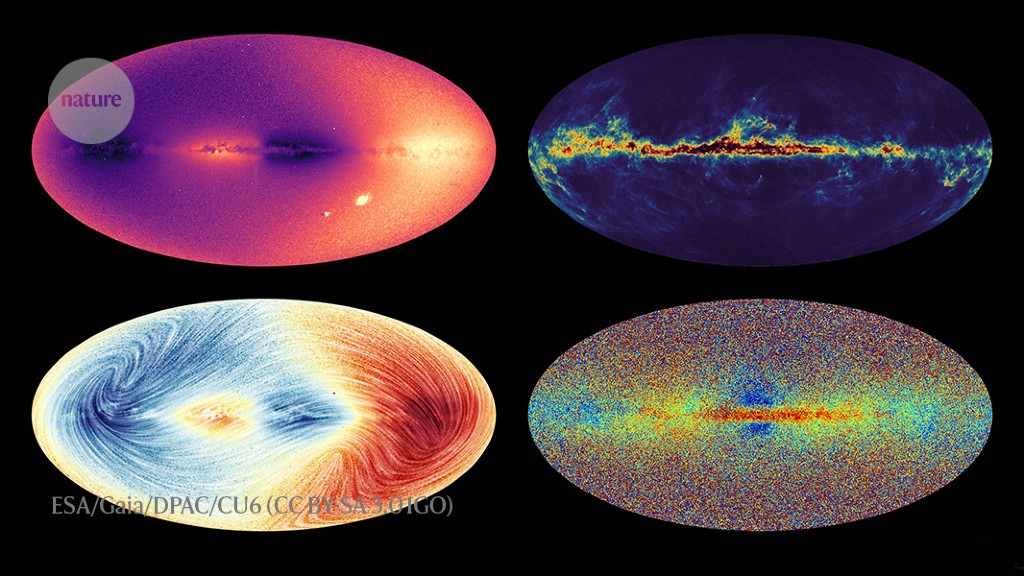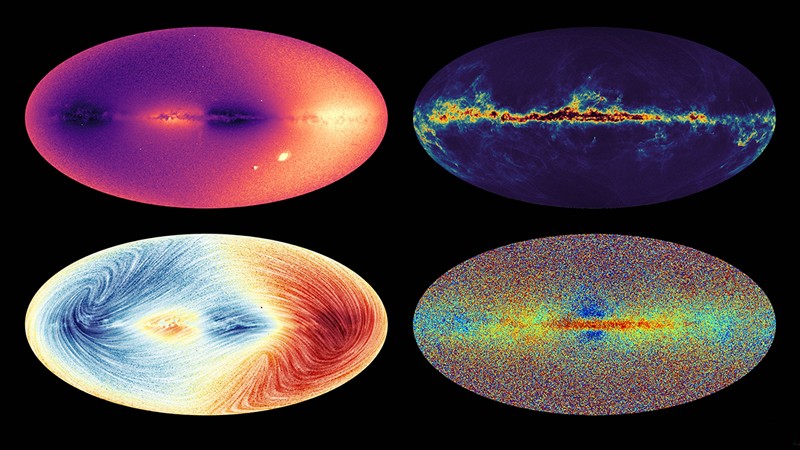Astronomers’ main reference guide to the Milky Way just received a major update. The Gaia mission, a spacecraft that is tracking nearly two billion stars, has released a vastly improved map, which now includes the three-dimensional motions of tens of millions of stars and thousands of asteroids, detections of stellar ‘quakes’ and of possible extrasolar planets.
The Gaia team unveiled the trove at a press conference on 13 June, together with around 50 scientific papers, and made the full database available for public download. The European Space Agency (ESA) probe launched the 2-tonne probe in 2013. Like an earlier database released in 2020, the latest release consists of 34 months’ worth of data collected between 2014 and 2017.
“Every day, five papers from Gaia are published,” said ESA director of science Günther Hasinger during an online presentation of the catalogue from Noordwijk, the Netherlands. “In the last three years we have overtaken the gold standard of astronomy, the Hubble Space Telescope, and we are now producing 1,600 papers per year.”
Detailed spectra
Gaia orbits the Sun at a fixed distance from Earth. Over the course of a year, it makes repeated measurements of the same stars from slightly different perspectives. This makes each star’s apparent position in the sky change by a tiny angle — typically millionths of a degree — which is proportional to its distance. The mission team then uses such changes and a technique called parallax to calculate the star’s distance from the Sun.
In addition, Gaia measures stars’ light spectra. The biggest addition to the previous catalogue is the vastly increased trove of detailed spectra, now comprising around 1 million stars. By measuring a doppler shift in the spectrum — akin to how the pitch of an ambulance’s siren depends on whether it is approaching or moving away — the team has calculated 30 million ‘radial velocity’ measurements, meaning the speed at which a star moves towards, or away from, the Sun. Together with Gaia’s measurements of the star’s motion across the sky and of its distance, the data provide a full reconstruction of the star’s trajectory as it circles the Galaxy.
One important application will be to detect and study clusters of stars that move together across the Galaxy, says Tereza Jerabkova, an astronomer at European Southern Observatory in Garching, Germany. “I think everyone in the star cluster community will jump on the new radial velocities that will allow to analyse more stars in 6D” — which include three dimensions for each star’s positions and three for its direction of motion.
Stellar wobbles
The Gaia catalogue now also includes information on how individual stars ‘wobble’, under the gravitational pull of a massive companion object. This way, the team has identified 800,000 binary systems — objects that appear to be single stars but are really two stars. In some cases, the pull appears to be not from a stellar companion but from a massive planet orbiting the star, says Gaia collaboration member Alessandro Sozzetti. “This whets our appetite,” says Sozetti, who is an exoplanet researcher at the Turin Astrophysical observatory in Italy. With several years’ more of observing data, the team expects to discover thousands of exoplanets.
Gaia’s planet-hunting techniques will complement those of dedicated exoplanet missions such as NASA’s Kepler and Transiting Exoplanet Survey Satellite (TESS), says NASA Exoplanet Archive project scientist Jessie Christiansen. Those missions are particularly sensitive to ‘hot giants’ — Jupiter-like planets that orbit very close to their stars — whereas Gaia will find many giant planets orbiting farther away and staying cooler, says Christiansen, who is at the California Institute of Technology in Pasadena. “The systems with cool giant planets are particularly interesting because they might be much more like our Solar System, which has cool giant planets, than the systems with hot giant planets found by Kepler and TESS.”
Gaia has already accumulated four more years of observations following those in today’s catalogue, and it will continue to release larger and improved data sets in the coming years. The €1-billion (US$1.2-billion) mission is set to take data until 2024, when its fuel is expected to run out.







More News
Author Correction: Stepwise activation of a metabotropic glutamate receptor – Nature
Changing rainforest to plantations shifts tropical food webs
Streamlined skull helps foxes take a nosedive